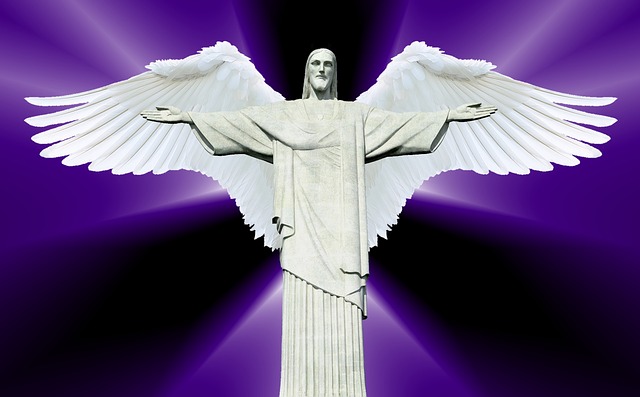The term “Messiah” holds significant meaning in the Bible, representing the promised savior and deliverer of the Jewish people. Throughout the Old Testament, various prophecies and symbols point to the coming of the Messiah, who is believed to bring salvation, redemption, and restoration to humanity. This article will explore the biblical symbolism and significance of the Messiah in the context of Christian and Jewish beliefs.
Table of Contents
Prophecies of the Messiah in the Old Testament
Have you ever wondered about the biblical meaning of the Messiah? The concept of the Messiah is central to both Judaism and Christianity, with the figure representing a savior or deliverer who will bring about redemption and salvation. In the Old Testament, there are numerous prophecies that foretell the coming of the Messiah, providing a roadmap for believers to understand the significance of this figure in the biblical narrative.
One of the most well-known prophecies of the Messiah is found in the book of Isaiah. In Isaiah 7:14, it is written, “Therefore the Lord himself will give you a sign: The virgin will conceive and give birth to a son, and will call him Immanuel.” This prophecy is often interpreted as foretelling the birth of Jesus Christ, who is seen as the ultimate fulfillment of the Messianic prophecies in the Old Testament.
Another important prophecy of the Messiah is found in the book of Micah. In Micah 5:2, it is written, “But you, Bethlehem Ephrathah, though you are small among the clans of Judah, out of you will come for me one who will be ruler over Israel, whose origins are from of old, from ancient times.” This prophecy points to the birthplace of the Messiah as Bethlehem, which is where Jesus was born according to the New Testament.
The prophecies of the Messiah in the Old Testament serve as a foundation for understanding the significance of Jesus Christ in the Christian faith. These prophecies provide a framework for believers to interpret the life, death, and resurrection of Jesus as the fulfillment of God’s plan for salvation.
In addition to the prophecies of the Messiah, there are also numerous symbols and types in the Old Testament that point to the coming of the Savior. One of the most well-known symbols is the sacrificial lamb, which is a foreshadowing of Jesus Christ as the ultimate sacrifice for sin. In the book of Genesis, Abraham is commanded to sacrifice his son Isaac, but at the last moment, God provides a ram as a substitute. This story is seen as a prefiguration of Jesus Christ, who is the Lamb of God who takes away the sins of the world.
Another important symbol of the Messiah in the Old Testament is the suffering servant. In the book of Isaiah, there are several passages that describe a servant who will suffer on behalf of the people and bring about redemption. This suffering servant is often interpreted as a reference to Jesus Christ, who willingly laid down his life for the salvation of humanity.
The prophecies and symbols of the Messiah in the Old Testament provide a rich tapestry of meaning for believers to explore and contemplate. These passages point to the central role of Jesus Christ in the biblical narrative, as the fulfillment of God’s plan for redemption and salvation. As we delve into the biblical meaning of the Messiah, we are invited to deepen our understanding of the significance of Jesus in our lives and in the world.
The significance of Jesus as the Messiah in the New Testament
The concept of the Messiah holds great significance in the Bible, particularly in the New Testament. The term “Messiah” originates from the Hebrew word “mashiach,” which means “anointed one.” In the Old Testament, the Messiah was prophesied as a savior figure who would come to redeem and deliver God’s people. This expectation was fulfilled in the person of Jesus Christ, who is regarded as the Messiah in the New Testament.
Throughout the New Testament, Jesus is portrayed as the long-awaited Messiah who came to fulfill the prophecies of the Old Testament. He is described as the anointed one who would bring salvation and redemption to humanity. The significance of Jesus as the Messiah is central to the Christian faith, as he is believed to be the Son of God who came to earth to reconcile humanity with God.
One of the key aspects of Jesus’ identity as the Messiah is his role as the suffering servant. In the Old Testament, the prophet Isaiah foretold of a servant who would suffer and die for the sins of the people. This prophecy is seen as being fulfilled in Jesus, who willingly laid down his life on the cross to atone for the sins of humanity. Through his death and resurrection, Jesus brought about salvation and reconciliation between God and humanity.
Another important aspect of Jesus’ identity as the Messiah is his role as the King of Kings. In the Old Testament, the Messiah was often associated with the idea of a king who would rule with justice and righteousness. Jesus fulfills this role as the King of Kings, who reigns over all creation with love and compassion. His kingdom is not of this world, but a spiritual kingdom that transcends earthly boundaries.
The symbolism of Jesus as the Messiah is further emphasized through his miracles and teachings. Throughout the New Testament, Jesus performs numerous miracles that demonstrate his divine power and authority. These miracles serve as signs of his identity as the Messiah and point to his role as the Son of God. In addition, Jesus’ teachings emphasize the importance of love, forgiveness, and compassion, reflecting the values of his kingdom.
The significance of Jesus as the Messiah is also seen in his ultimate victory over sin and death. Through his resurrection from the dead, Jesus conquered sin and death, offering the promise of eternal life to all who believe in him. This victory over sin and death is central to the Christian faith, as it demonstrates the power of God to overcome all obstacles and bring about redemption and salvation.
In conclusion, the biblical meaning of Messiah is rich with symbolism and significance. Jesus Christ is portrayed as the long-awaited Messiah who came to fulfill the prophecies of the Old Testament. His identity as the suffering servant, King of Kings, and victorious Savior is central to the Christian faith. Through his life, death, and resurrection, Jesus brought about salvation and reconciliation between God and humanity. The significance of Jesus as the Messiah is a central theme in the New Testament, emphasizing his divine identity and role as the Son of God.
The role of the Messiah in salvation and redemption

The concept of the Messiah holds significant importance in the Bible, with various prophecies and symbols pointing towards the coming of a savior who would bring salvation and redemption to humanity. The term “Messiah” originates from the Hebrew word “mashiach,” which means “anointed one.” In the Old Testament, the Messiah is often referred to as the promised deliverer who would bring peace, justice, and restoration to the world.
One of the key roles of the Messiah in biblical symbolism is that of a king. In the Old Testament, there are numerous prophecies that speak of a coming king who would reign with righteousness and establish a kingdom that would never end. This king is often referred to as the “Son of David,” linking him to the lineage of King David, who was a revered figure in Israelite history. The Messiah’s role as a king signifies his authority and power to rule over the earth and bring about God’s kingdom on earth.
Another important aspect of the Messiah in biblical symbolism is that of a suffering servant. In the book of Isaiah, there are prophecies that speak of a servant who would suffer and die for the sins of humanity. This servant is described as being despised and rejected by men, bearing the iniquities of others, and ultimately being exalted by God. This imagery of a suffering servant points towards the sacrificial death of Jesus Christ, who is seen as the ultimate fulfillment of these prophecies.
The Messiah is also portrayed as a shepherd in the Bible, symbolizing his role as a protector and guide for his people. In the book of Psalms, God is described as a shepherd who leads his flock to green pastures and still waters, providing for their needs and protecting them from harm. This imagery is often applied to the Messiah, who is seen as the Good Shepherd who lays down his life for his sheep. The shepherd symbolism highlights the Messiah’s compassion, care, and love for his people.
The Messiah is also depicted as a light in the darkness, bringing hope and salvation to a world engulfed in sin and despair. In the book of Isaiah, there are prophecies that speak of a light shining in the darkness, bringing illumination and guidance to those who are lost. This imagery of light symbolizes the Messiah’s role as the source of truth, wisdom, and salvation for all who believe in him. Jesus Christ is often referred to as the Light of the World, who dispels the darkness of sin and brings light into the lives of his followers.
In conclusion, the biblical symbolism of the Messiah is rich and multifaceted, encompassing various roles and attributes that point towards his significance in salvation and redemption. The Messiah is portrayed as a king, a suffering servant, a shepherd, and a light in the darkness, all of which highlight his authority, sacrifice, care, and salvation for humanity. Jesus Christ is seen as the ultimate fulfillment of these prophecies, bringing hope, peace, and redemption to all who believe in him. The symbolism of the Messiah in the Bible serves as a powerful reminder of God’s love and grace towards his people, offering them a way to salvation and eternal life.
Biblical symbols associated with the Messiah
The concept of the Messiah holds significant importance in the Bible, with various symbols and prophecies associated with this figure. In Christian theology, the Messiah is believed to be the savior of humanity, sent by God to redeem and deliver His people. Throughout the Bible, there are numerous symbols that point to the coming of the Messiah and his role in fulfilling God’s plan for salvation.
One of the most well-known symbols associated with the Messiah is the Star of Bethlehem. According to the Gospel of Matthew, a bright star appeared in the sky to guide the wise men to the birthplace of Jesus. This star is often seen as a sign of divine intervention and a symbol of hope and salvation. The Star of Bethlehem is a reminder that the Messiah’s arrival was foretold and that he came to bring light into the world.
Another important symbol associated with the Messiah is the lamb. In the Old Testament, lambs were often used as sacrificial offerings to atone for sin. In Christian theology, Jesus is often referred to as the “Lamb of God” who takes away the sins of the world. The symbolism of the lamb represents Jesus’ sacrificial death on the cross, which was seen as the ultimate act of love and redemption.
The lion is another symbol associated with the Messiah in the Bible. In the Book of Revelation, Jesus is referred to as the “Lion of the tribe of Judah,” symbolizing his strength, power, and authority. The lion represents Jesus’ role as a conquering king who will reign over all nations and establish God’s kingdom on earth. The symbolism of the lion reminds believers of Jesus’ sovereignty and his ultimate victory over sin and death.
The olive tree is another symbol associated with the Messiah in the Bible. In the Old Testament, the olive tree was often used as a symbol of peace, prosperity, and God’s favor. In Christian theology, the olive tree represents Jesus as the source of life and nourishment for believers. The symbolism of the olive tree reminds believers of their connection to Jesus and the abundant blessings that come from being rooted in him.
The crown of thorns is a powerful symbol associated with the Messiah’s suffering and sacrifice. In the Gospel accounts of Jesus’ crucifixion, Roman soldiers placed a crown of thorns on his head as a cruel mockery of his claim to be a king. The crown of thorns represents Jesus’ willingness to endure suffering and humiliation for the sake of humanity. It is a reminder of the depth of Jesus’ love and his ultimate sacrifice on the cross.
In conclusion, the symbols associated with the Messiah in the Bible serve as powerful reminders of Jesus’ identity, mission, and significance in the Christian faith. From the Star of Bethlehem to the crown of thorns, each symbol points to a different aspect of Jesus’ life, ministry, and ultimate victory over sin and death. As believers reflect on these symbols, they are reminded of the profound love and grace that Jesus offers to all who believe in him. The symbols of the Messiah in the Bible are not just abstract concepts; they are living reminders of God’s presence and power in the world.
The Second Coming of the Messiah in the Book of Revelation
The Book of Revelation is the final book of the Bible, and it is filled with vivid imagery and symbolism. One of the key themes in Revelation is the second coming of the Messiah, also known as the return of Jesus Christ. This event is described in great detail in the book, and it is a central focus of Christian theology.
In Revelation, the second coming of the Messiah is depicted as a dramatic and awe-inspiring event. Jesus is described as coming on the clouds with great power and glory, accompanied by a host of angels. The earth trembles at his presence, and every eye will see him, even those who pierced him. This event is seen as the culmination of history, when Jesus will return to judge the living and the dead and establish his kingdom on earth.
The imagery used in Revelation to describe the second coming of the Messiah is rich with symbolism. The clouds represent the glory and majesty of God, while the angels symbolize the heavenly host that accompanies Jesus in his return. The trembling of the earth signifies the power and authority of Jesus, while the reference to those who pierced him points to the fulfillment of prophecy and the final judgment.
The second coming of the Messiah in Revelation is a reminder to Christians of the ultimate victory of Christ over sin and death. It is a source of hope and encouragement for believers, who look forward to the day when Jesus will return to set things right and establish his kingdom on earth. The imagery used in Revelation serves to reinforce this message and to inspire faith and devotion in the hearts of believers.
The second coming of the Messiah is also a call to action for Christians. In Revelation, Jesus warns his followers to be vigilant and to remain faithful, so that they will be ready when he returns. This message is meant to encourage believers to live holy and righteous lives, and to be prepared for the day when Jesus will come again.
Overall, the second coming of the Messiah in the Book of Revelation is a powerful and evocative image that serves to remind Christians of the ultimate victory of Christ and the hope that they have in him. The symbolism used in Revelation is rich with meaning and significance, and it serves to inspire faith and devotion in the hearts of believers. As Christians look forward to the return of Jesus, they are called to live lives of faithfulness and obedience, so that they will be ready when he comes again.
Conclusion
The Biblical meaning of the Messiah is a figure prophesied in the Old Testament to be a savior and deliverer of the Jewish people. The Messiah is seen as a symbol of hope, redemption, and salvation for believers. Throughout the Bible, various prophecies and symbols are used to describe the coming of the Messiah, who is believed to bring peace, justice, and eternal life to humanity. The concept of the Messiah is central to Christian and Jewish faiths, representing the fulfillment of God’s promises and the ultimate victory over sin and death.
For licensing reasons, we must provide the following notice: This content was created in part with the help of an AI.


